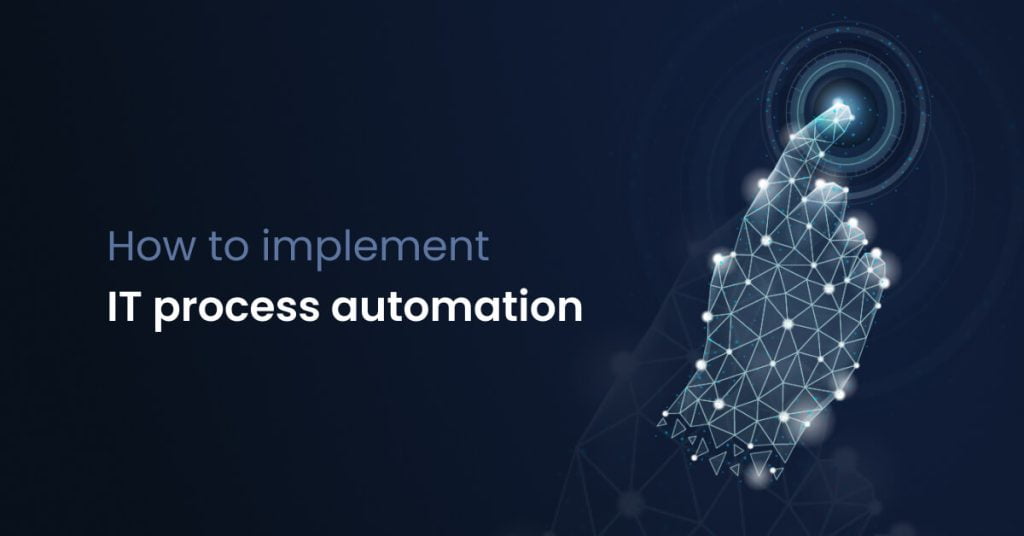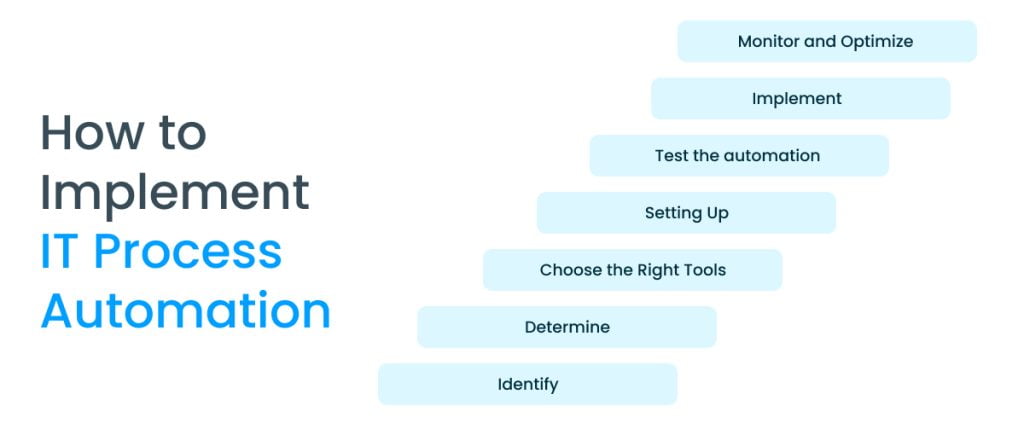
As we approach the end of 2023, it is evident that IT process automation has put large enterprises on the verge of a transformative shift. The catalyst for this transformation? The widespread adoption of AI-powered automation. At the heart of this revolution lies the strategic deployment of IT process automation.
Understanding IT Process Automation
This phenomenon promises to revolutionize the landscape of IT departments, elevating productivity, and scalability to unprecedented levels. This strategic shift towards IT process automation promises a dual benefit: substantial cost reduction and enhanced operational efficiency. How does it work? By entrusting routine, repetitive tasks to a digital workforce. This, in turn, paves the way for improved communication channels within your organization. The implications are vast, affecting not only the bottom line but also the agility and responsiveness of your IT teams.
Yet, the journey toward automation success begins with a critical first step: identifying the right tasks for automation. To extract the utmost value from your automation efforts, it is essential to carefully select the appropriate tools that align with your automation objectives. This ensures that your IT processes are not only streamlined but also optimized for efficiency. Equally critical is ensuring that everyone involved in this transformative journey, from managers and staff to customers and suppliers, comprehends the objectives and gains insight into the tangible benefits of the IT process automation project. This creates a collaborative atmosphere that is essential for a successful transition.
However, the true power of IT process automation emerges when it is executed meticulously. Tasks that are prime candidates for automation include software testing, server provisioning, application monitoring, and incident response. IT process automation empowers the IT teams to resolve issues with swiftness and precision, thus raising the bar for service quality.
To delve deeper into the successful implementation of IT process automation, let us dive deep into this blog. The journey is not just about adopting a trend; it is about crafting a strategic approach that can transform the very core of your IT operations.
How to Implement IT Process Automation

In today’s rapidly evolving business landscape, the implementation of IT process automation has become a critical endeavor for companies seeking efficiency and productivity gains. Whether it is streamlining routine tasks, reducing manual interventions, or enhancing collaboration, IT process automation is the cornerstone of modern business operations. Let us delve into the intricacies of implementing this transformative technology.
1. Identify
The first crucial step on the road to IT process automation is to identify the specific processes within your organization that can benefit from automation. To do this effectively, you should leverage key performance indicators (KPIs) and metrics. These metrics will serve as your compass, guiding you towards the processes most ripe for automation.
For instance, if you have a time-consuming process that involves frequent communication among your employees, it is an ideal candidate for automation. Imagine a scenario where your team members are repeatedly exchanging information to accomplish a task. Automating this process can free up their time and energy for more strategic activities.
2. Determine
For each process you have identified for automation, a clear understanding of its requirements is essential. You will need to assess the tools, whether hardware or software, that are indispensable for automating these processes. This is where IT process automation comes into play, as IT processes often require specific software and hardware solutions.
Moreover, you should consider the data involved and the necessary permissions. Access control and data security are paramount for IT process automation. Your automation system should ensure that only authorized personnel can access and modify data.
Another critical aspect is the end users of the automation. You will need to map out how employees will interact with the automated processes. For instance, if you are automating a workflow that requires input from multiple team members, you must create a user-friendly interface where they can efficiently submit their data. This ensures that the automation not only speeds up the process but also enhances collaboration among your workforces.
3. Choose the Right Tools
Implementing IT process automation begins with selecting the most suitable tools for your organization. The process may seem daunting, but with careful consideration, you can streamline your operations efficiently. Here are some crucial factors to take into account:
Ease of Use: It is imperative that the IT process automation tools you choose are user-friendly. Your team members and employees should be able to integrate them into their workflow without the need for extensive training. Simplifying the transition to automation enhances productivity and reduces resistance.
Flexibility: Your chosen digital workforce should possess adaptability, just like your business does. The IT process automation tools should be capable of evolving with your organization as it undergoes changes. Whether you are expanding, diversifying, or modifying your processes, your automation tools should remain an asset, not a limitation.
Compatibility: Compatibility is key. Make sure the automation platform seamlessly integrates with your existing software and hardware infrastructure. This ensures that you can maintain a cohesive ecosystem within your IT environment. A well-integrated automation solution prevents disruptions and enhances overall efficiency.
Cost Consideration: Automation tools come in a variety of price ranges. It is crucial to evaluate your budget when selecting the tools. Consider the long-term ROI (Return on Investment) when assessing the cost, as effective IT process automation can lead to significant savings and improved productivity.
4. Setting Up
The setup phase of IT process automation is variable and depends on the specific hardware and software solutions you have chosen. Here is how to get started:
Follow Manufacturer Instructions: Refer to the manufacturer’s guidelines and instructions provided for the hardware and software tools you have chosen. This ensures that you set them up correctly and configure them to align with your business needs. Accurate setup is essential to harness the full potential of automation.
Compatibility Check: If you are using multiple automation tools, it is critical to confirm that they are compatible with each other. A seamless workflow requires all components to work harmoniously. Ensuring compatibility avoids operational hiccups.
Data Input Preparation: As part of the setup, you will need to create any necessary data inputs, such as forms or templates. These inputs are the building blocks of your automated processes. Ensuring that they are designed to capture the right information is essential for the success of IT process automation
5. Test the automation
Before deploying IT process automation in a live operational environment, it is crucial to rigorously test all aspects of the automation system. This includes assessing the data inputs and outputs and verifying the accuracy of any predefined rules and alerts configured. By conducting comprehensive testing, you can ensure that the IT process automation is functioning as intended. This step is essential to prevent any potential disruptions to your business operations, which could arise from errors or unexpected behaviors within the automation.
6. Implement
Once you have thoroughly tested the automation and are confident in its functionality, it is time to move forward with the implementation phase. This involves not only deploying the technology but also ensuring that your employees are well-prepared to use it effectively. Training your workforce on how to utilize IT process automation is a critical aspect of this stage. It is important to provide the necessary support and resources to assist your employees in adapting to this new system. Just like with any modern technology, there might be initial challenges or adjustments required, but keep in mind that IT process automation has the potential to bring significant enhancements to efficiency and productivity across your organization.
7. Monitor and Optimize
The implementation of IT process automation is not a one-and-done endeavor; it requires ongoing monitoring and optimization. Your business environment and operational needs may evolve over time, and employee feedback can provide valuable insights into areas where improvements are necessary. Therefore, it is essential to establish a routine process for monitoring and evaluating the performance of your IT process automation. This ensures that the system continues to align with your organization’s objectives and remains efficient. By staying vigilant in your monitoring efforts, you can swiftly identify and address any issues that may arise, keeping your IT operations automation finely tuned and highly effective.
The implementation of IT process automation is a multifaceted endeavor that can revolutionize the way your business operates. By thoroughly testing the automation, training your team, and continually monitoring and optimizing the processes, you unlock the full potential of automation tools. Embracing IT process automation not only ensures smoother operations but also positions your business for greater efficiency and productivity. It is a dynamic journey that, when executed effectively, can lead to substantial gains in your organization’s competitiveness and bottom line. So, take these steps to heart and start reaping the benefits of IT process automation today.
Making IT Process Automation a Reality with SquareOne
When it comes to IT process automation, there are many factors to consider; however, careful planning and execution, and taking the time to plan and choose the right tools can positively impact your business. SquareOne proudly stands out in delivering expertise to implement robust IT process automation.
We specialize in providing cutting-edge digital transformation and workflow automation solutions to a wide array of companies and businesses. Our extensive experience and a deep understanding of IT operations makes us a trusted partner in streamlining your IT processes automation. Our tailored solutions are designed to meet the unique needs of your organization, ensuring that IT process automation is not just a goal but a reality.
By collaborating with SquareOne, you can take your IT operations to the next level. Our expertise ensures that your processes are not only automated but also optimized, leading to increased efficiency, and reduced operational costs. With SquareOne in the picture, your journey towards seamless IT process automation becomes a promising reality.
Incorporating SquareOne’s expertise into your IT process automation strategy is a step forward in ensuring your business stays competitive and agile in this fast-paced digital era. So, if you are looking to make IT process automation happen and experience the benefits it offers, consider SquareOne as your partner in this transformative journey.

















